When Director Scott Walker (The Frozen Ground) was searching for a VFX artist to create the amphibious man-eating creature for his sophomore film The Tank, which he also wrote and produced, he didn’t need to look any further than his own New Zealand backyard to find the perfect man for the job. Fellow Kiwi Richard Taylor, the award-winning Founder and Creative Director of the special effects company Weta Workshop, was gleefully game for the gig despite having to work with a much lower budget than the epic films on which his company and design team have previously worked.
Taylor’s special effects pedigree speaks for itself, having created all of the props, costumes, prosthetics, miniatures, and weaponry for Peter Jackson‘s The Lord of the Rings film trilogy, for which he shared four Academy Awards — two (makeup and visual effects) for The Lord of the Rings: The Fellowship of the Ring, and two (makeup and costume design) for The Lord of the Rings: The Return of the King. His other credits include Avatar, Thor: Ragnarok, Jackson’s King Kong, and The Chronicles of Narnia: The Lion, the Witch, and the Wardrobe, to name just a few.
The Tank follows a family that inherits an abandoned coastal property and accidentally awakens a deadly creature that lurks beneath it. The team at Weta Workshop, which is headquartered in Wellington, New Zealand, worked closely alongside Walker, who imagined the creature from head to tail before sharing his inspirations with Taylor, who helped bring the creature to fruition. The result is a fully practical suit made of heavy silicone and featuring movable layered jaws that open both horizontally and vertically, and also release goopy slime when it attacks its victims.
Below the Line recently spoke with Richard Taylor and Scott Walker via Zoom, and the three of us chatted from three different time zones. It was late in the evening for Taylor, who was talking softly in a Barcelona hotel so as not to wake his wife and daughter while they slept in the next room, though it was early morning for Walker, who sat in a glass-enclosed room in his New Zealand home as he gazed upon the overcast Auckland skies. The creature collaborators discussed the making of the monster and the backstory behind its origins, with Walker “geeking out” over its biology. They also discussed casting the creature, and how the family — played by Luciane Buchanan, Matt Whelan, and Coco White — interacted with it. During our chat, Walker would proudly hold up a model of the creature’s head to illustrate its impressive mechanics.
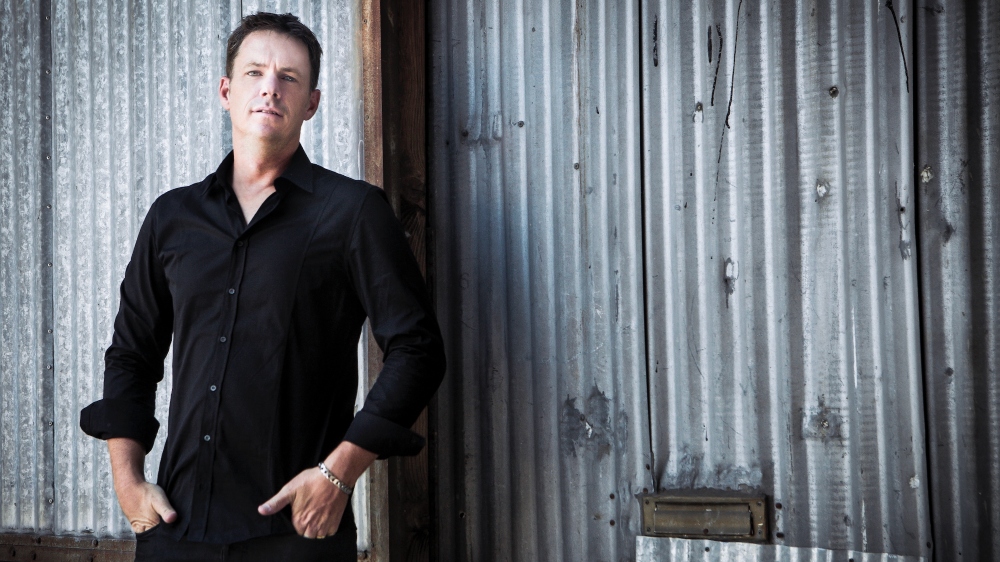
Below the Line: Good morning… and good evening! Can you tell me the story of how the two of you first connected?
Scott Walker: We actually connected quite a while ago through Barry Osborne, who’d produced The Lord of the Rings. It was to do with another project, a werewolf project, which is now being lined up next. It’s a bigger world and a bigger film. So we’ve kind of been in touch on and off, talking about that for quite a while. Then The Tank came along, and it was a perfect opportunity. I was back in New Zealand when COVID happened, and it was like, “This is something a little bit more manageable. Can we push the boundaries on it as much as possible?” That kind of got us actually working together.

BTL: What were your initial thoughts about getting involved in this film?
Richard Taylor: Well, firstly, Robin, we obviously forged our career making low-budget monster movies, or at least practical effects creature movies. And these come around very rarely. There’s a misconception that we must surely only work on blockbuster feature films. But, of course, we are always hanging out in the hope that a director such as Scott will phone us up and invite us to be part of something like this.
BTL: What was the inspiration for this creature?
Taylor: I’d love to say it was Scott, who, in a not-so-common way, actually wrote a very extensive document about the biology of this creature, going to incredible depths around the nature of its genesis, how it came to be, what it was as a species, and the fact that it had a female quality to it. Maybe it was asexual; maybe it was a lizard-like reptile living underground. He shared an amazing resource of inspiration and ideas with us. So we had a great jumping-off point for the concept design process, which meant that we were able to actually design it very quickly.
We had a short amount of time to make it, so we needed to get through the concept design quickly just so we could get into manufacturing. Really, Scott, in a very short number of rounds, working with you, we were actually able to quite quickly get the creature locked down, considering it’s one of the primary characters in the movie, in a very important part of the film. It could have taken a significant amount longer if Scott didn’t have a very strong vision for what he wanted in his head.
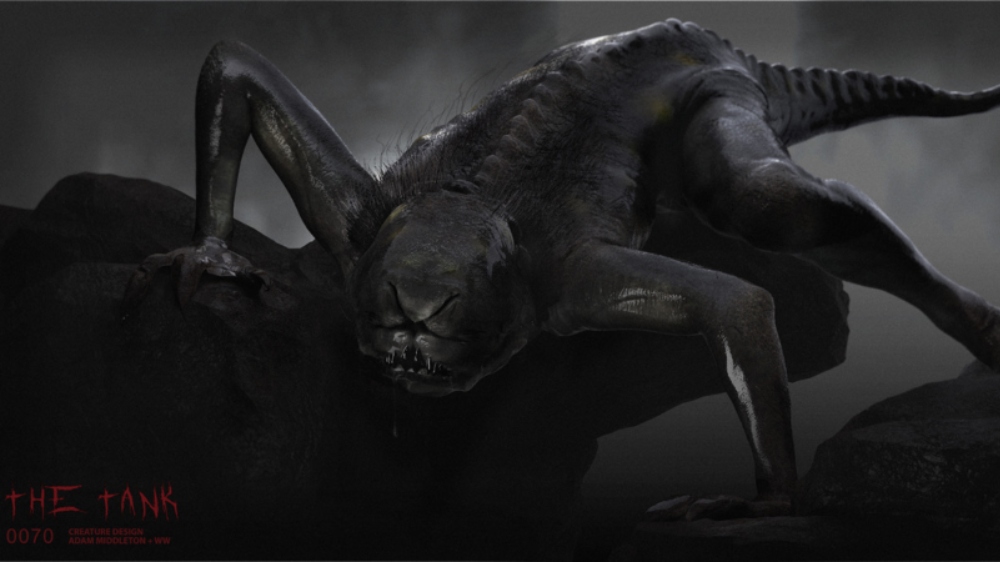
BTL: So, Scott, did you actually illustrate to Richard what you wanted it to look like, or did you verbally describe it to him?
Walker: I had references to parts, like, “It’s part like this, it’s part like that.” Then I had a lot of examples of what it’s not like, which was actually great. To start with, a creature like this is going to be a person in a practical suit, so it’s going to have four limbs. I knew it was feminine, not masculine, so it wasn’t predator size; it was smaller, live, and muscular, so that starts to really narrow it down. I geeked out as if I were doing a Ph.D. on this creature; here’s a synopsis of what its attributes, phenotype, and all that sort of stuff are, and Richard and I would just text backward and forwards. I wanted it to be earthbound. To me, it had to be real, like it could really exist.
And so we would be like, “Have you seen a hagfish?” A hagfish has jaws that go sideways. And we were like, “Oh, that’s really gross but really cool. So how can we incorporate that?” I knew it was amphibious, so it would breathe through its skin, so its skin had to have this translucent, tactile gumminess to it. We had this idea that it had these hairs, so, like, this is her here (holding up its head), and it’s got these hairs coming off the side here, which are sort of like former gills when it lived underwater. Once we had the shape, size, and general look, Richard’s team [did] some fantastic, really early concept work.
BTL: How did it evolve from the concept work?
Taylor: They were all conceptual steps toward the final design. The first design that we did was done by a young designer named Max in our concept design studio. It would be within, probably, 20 percent of the final design, so it was really a subtle process of honing the design. As you probably appreciate, Robin, when you build a creature suit around an actor, there are very strong limitations. The distance under the arms [and] across the chest… you can obviously widen that distance, but then you lose the mobility of the upper arms. The distance from the clavicle to the underside of the groin determines the body proportion. If you want mobility in the neck, you have to allow for the vertebrae of the neck to work, so there are very strong restrictions that come into play that you don’t need to acknowledge if you’re doing it digitally.
But one of the great benefits of those restrictions is that they allow a very quick refinement of a concept within a very tight set of parameters. I feel confident that the creature ultimately achieved if not all of Scott’s aspirations, many of them within the confines of what you can actually do with a person in a suit. Of course, the whole thing then hangs on the capabilities and performance prowess of the person actually wearing the suit. and, to a great degree, the actor’s response to that character. I have been assured by Scott that both the actor in the suit and the performers acting opposite delivered a very convincing result. So that’s really great.
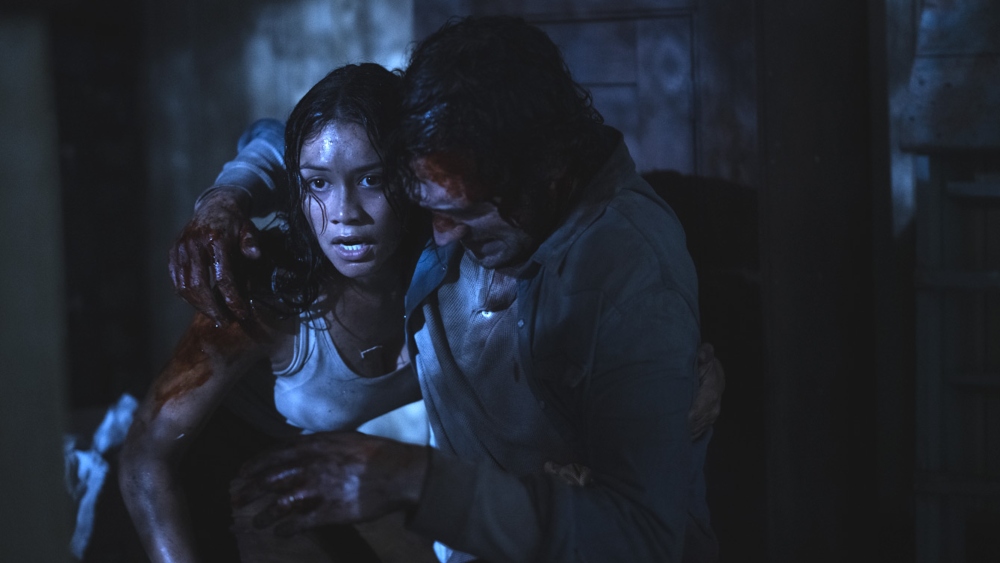
BTL: What were the auditions like to cast the creature?
Taylor: When Scott asked me to do a casting call, it was important that we do it because we were building the suit in Wellington. Scott was in Auckland and was going to ultimately film in Auckland. But when you build a suit, you need the actor to come in many times, and we were under COVID restrictions, plus, we didn’t want to incur the production cost of flying a person [back and forth] between the cities. So we did an initial casting call in Wellington.
The very first person that we found was a contortionist working in the circus. There’s a misconception that when you hire a contortionist, you’re going to use them for their contortionist abilities. You very rarely do, but what you are doing is using a person who has extraordinary control over their own physicality. They’re invariably incredibly powerful, um, for their size.
In the case of Regina Hegemann, she’s only 4′ 11″, [maybe] five feet tall, but absolutely frenetic and powerful with incredible physical control over her muscular movement and also psychologically able to pacify herself when she’s swaddled in layers of heavy silicon underwater fighting with an actor. So we almost jinxed ourselves by thinking that we could have possibly found the person on the very first casting call, but that’s ultimately what was achieved.
BTL: What were the challenges of designing the suit for Regina?
Walker: Early on, I made the decision that this was not [a] bipedal, and I’d actually written at one point that it was, and so we talked about it standing up, which in some ways would’ve made life a lot easier because someone standing up, kind of like the creatures in The Descent, is clearly humanoid. If you go down that road, you can do a lot of things that are far easier for a performer than if they have to be on all fours. In particular, Regina could be on all fours with her elbows above her shoulders and her knees above her hips and still crawl. That was just a restriction that was like, “Okay, well, how do we work into that to give us this thing, which is clearly a reptilian creature, not a humanoid?”
BTL: What were the logistics of shooting the creature?
Walker: Then it was really about fine-tuning the specific details along with the practicality of, “we’ve got to put a person inside this, and they’ve got to be able to move in a way that I wanted them to move as freely as possible.” They’ve got to be able to fight someone underwater, and every angle will be caught by the camera if I’m shooting it very handheld and verite. I didn’t storyboard the film. I sort of blocked it in my head, but it was like, “We’re not going to have a close-up on the head and then a close-up on the feet.” All the fights were choreographed with all of that in mind. So all of that thinking had to go back to, “How do we [design] this suit so that we have that freedom to do that when we actually get in the tank?”
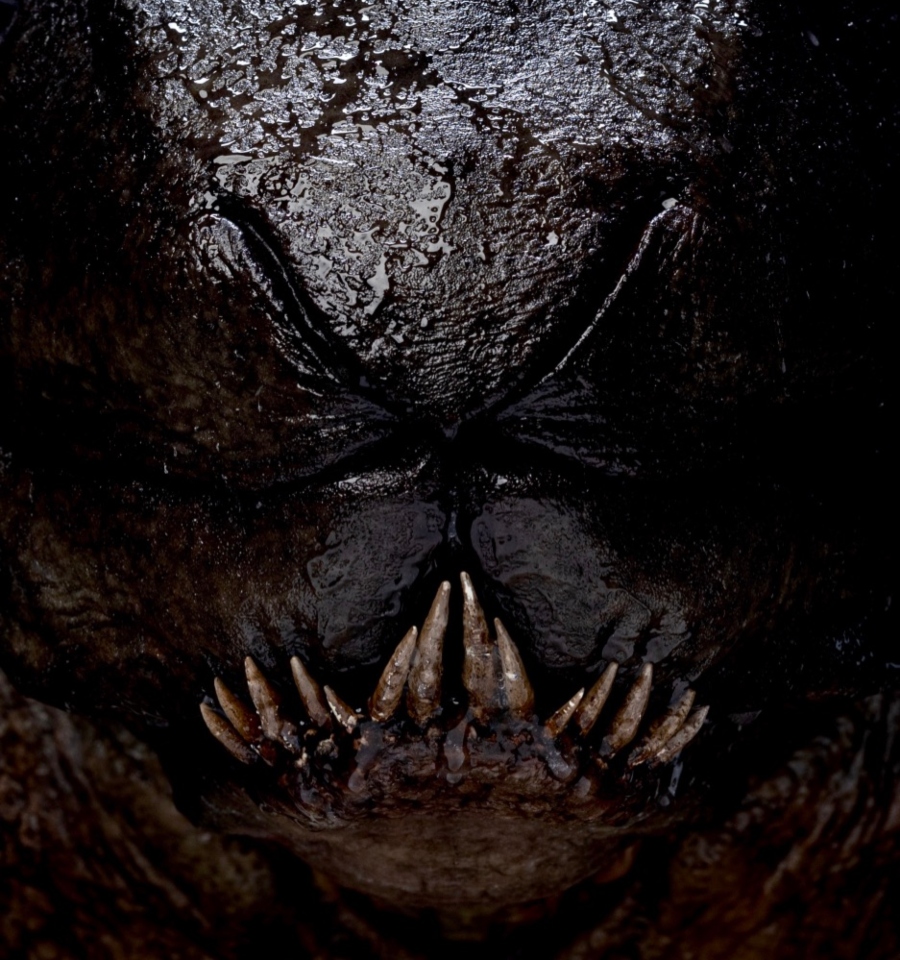
BTL: So tell me the secret behind the jaw and how it worked with the teeth coming out, almost in layers.
Walker: [holding up the head] I don’t have all the cables connected to this at the moment, but this was an idea that we had late in the process. I wanted to be able to reveal the creature in sort of set stages, seeing a little bit more of it and more of it. Then we actually see the creature in the first attack. Then I was like, “What can we do beyond that for the next attack?” Richard and I were thinking about the Hagfish conversation of, like, “Have you seen Hagfish in its environment?”
We had some physical limitations with what we could do with the mask. It has these side jaws, which would be useful if it were an ambush predator for just kind of grabbing hold of something. That was the thinking behind it — wanting to add another layer of complexity to the creature’s evolution and design. [It was] also something that would be an extra thing for the audience to see it do, which was very dramatic [on] camera as well.
Taylor: We wanted [it] to be like a hairless mole rat, so you can’t really make out what it is — whether it has eyes, whether it has a nose. Is that a jaw? It doesn’t have opposing thumbs, so it can’t grab its prey. It’s got to do it all with its mouth the way a dog or a wolf does, so therefore, its opening side jaws actually act as an ability to pull its victim into its gullet.
BTL: Did you affectionately give the creature a name?
Walker: I think I came up with NTG-OR348 for Nocto-Terragenus, better known as just Terragenus, which means origin of species from underground or something like that. I’m not a scientist, I just made it up. [laughs]
Taylor: We did have some fun names for it while it was in the workshop. Many, many, many movies have traveled through our buildings since we finished The Tank, so I can’t remember what it was called, but it was very sweet and very endearing. You know, you do fall in love with the things that you make, and you are intensely working on them for a period of time, so I always feel that it’s been disingenuous to the director if you don’t find affection in the things that you make. We definitely found it in this character.
Walker: Which is very sweet. She’s very cute, you know!
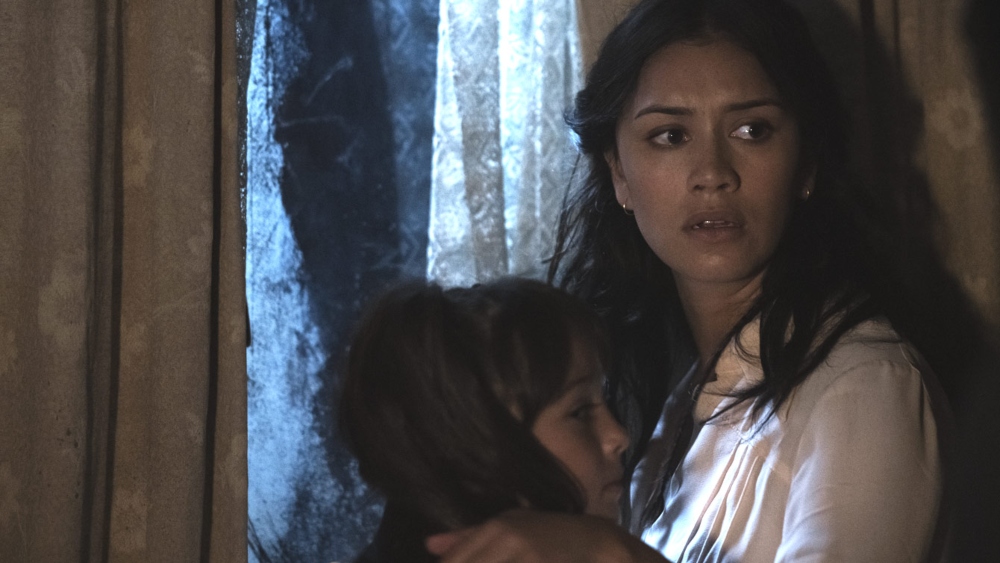
BTL: What is the goopy stuff that comes out of her mouth?
Taylor: It’s methylcellulose. We built pumps into its mouth so that we could literally pump the gloop through its lips so that you constantly have this oozing. Like a hagfish, it has this oozing, mucusy, disgusting-looking stuff coming out of it.
Walker: What you can’t tell from this is that Richard and his team have got all the hydraulics in the face, like to make its nostrils move and its jaws move, and it’s got hoses coming out of its nostril so it could snort. It has holes in its mouth where this goo could be pumped out so it can drool. It was very funny every time before we’d shoot. I mean, this stuff starts to dry quite quickly, and so Regina would be standing there and we’re about to roll the camera, and then the team would come in and just completely cover her in all these different viscosities of slime for different parts of the head — the back, the hair, the mouth. It was great fun.
BTL: What would you say were the biggest challenges in terms of having this creature actually scare audiences?
Walker: It’s a classic monster movie. The positive of a person in a suit is that the actors have something to interact with, you can do a lot more, and you’re not going to fix it in CGI. Then that is a challenge as well because it’s a person in a suit. So you’re always thinking, “How do I only show part of it through lighting, camera angle, and performance so that we never fully reveal things that would make it obviously look like a person in a suit?” It’s not The Creature From the Black Lagoon‘s territory.
I always thought of the film as almost a hybrid of two films. The first half is more like a haunted house story like The Conjuring, where things go bump in the night, and it’s about building fear and suspense through what you can’t see. Then the second half, once you see the creature, it’s on, and it’s the intensity and the action of, “Will anybody get out of this place alive?”
Once you’ve seen the creature, you are free to do more of it. But it was always about how we keep it moving [and] shoot it in a sort of verite, very personal way, and get close enough so that we’re [merely] glimpsing the creature. These days, you just put a big CGI creature in the middle there, and you can see it all. With a practical creature, you have to think a little bit more about how you’re going to frame it in or out so that you can kind of keep the illusion alive and let the audience’s imagination really play a bigger part.
BTL: Richard, when you look back at your body of work, what are you most proud of?
Taylor: I’m most proud of the fact that, as a company, we’ve just finished six and a half years on Avatar. We’ve just done Black Panther, and we’ve just finished Thor. As a company and as a group, Weta Workshop is still driven, excited, and enthralled by the opportunity and capable of doing low-budget New Zealand horror movies or anyone’s horror movies. We’ve just done a very low-budget creature feature for an Australian director.
I love the fact that our team finds it irrelevant what the scale of the film is or the possible grandstanding that one might get from a film’s prestige. It’s all about making the content. It’s all about working with the director to produce something original, fun, creative, and, in this case, hopefully scary. That’s ultimately what I’m most proud of — filmmakers making great films together. That’s what it’s all about.
The Tank is now playing in select theaters, and it’s available to buy or rent on all major VOD/digital platforms courtesy of Well Go USA.





